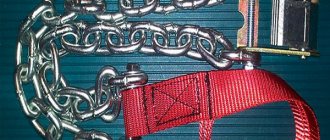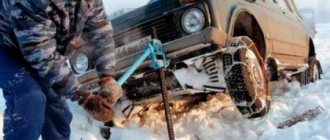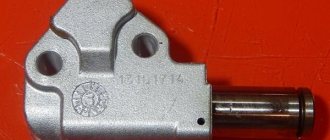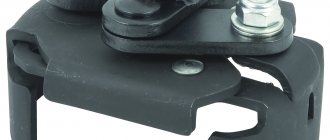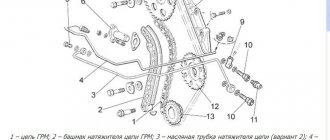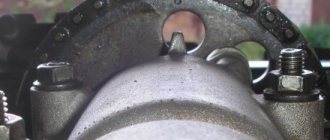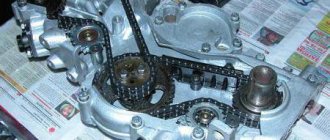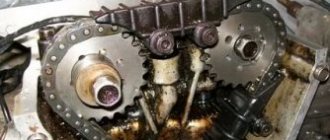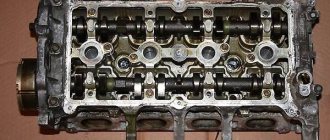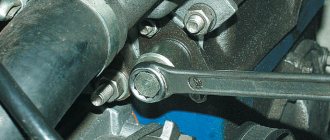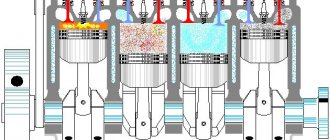Cars admin26.02.2020
Car snow chains are a replaceable tread that allows you to transform a typical road tire into an all-terrain wheel for off-road driving, icy conditions, deep mud, snow, etc.
Bracelet and snow chains
This device is made of reinforced wire and tied in such a way that it evenly braids the wheel around the entire circle. The chain consists of external and internal longitudinal parallel cables connected by transverse chains or rubber so-called lugs, which significantly increase the adhesion of the wheels to the road surface.
Types of Snow Chains
Several types of chains are available:
- Rubber chains, whose advantage is that they are installed on absolutely any rubber, evenly entangle the wheel, are easy to install, do not destroy the tire tread, and retain their elasticity in winter;
- Metal with different types of weaving;
- Economy class chains. This type is only used on stuck car wheels.
Varieties of design
Snow chains differ in size and shape of links. A variety of materials are used for their manufacture (steel, aluminum, titanium, reinforced plastic, etc.).
Depending on the conditions of use and capabilities, three main types of weaving are made:
1. A ladder in which the cables are connected by straight transverse pieces. This is a fairly simple, fairly practical and easy to implement system. However, it has a drawback - the car can move jerkily.
2. A rhombus in which the connection is made obliquely, resulting in a pattern in the form of a web.
3. Honeycombs. This design is a little more complex, the longitudinal cables are connected diagonally, resulting in an intertwined pattern.
Making your own chains
Making snow chains with your own hands is not so difficult at home, because you may need them at the most inopportune moment. For this you will need:
- Bulgarian;
- Vise;
- Chain;
- Several dozen connecting links or carabiners;
- Hooks;
- Tensioning devices;
- Several hours of time.
Making a chain
Simple instructions on how to make your own snow chains:
1. First of all, you need to choose a suitable chain. Its links should be welded, not soldered, and the length should be sufficient to braid the entire wheel.
Important! It is necessary to use reinforced wire for the chain; otherwise, at high speeds or towing, it may break and cause injury.
2. Choose a chain design that suits you, such as a ladder.
You can do it like this: 1 – transverse branches, 2 – longitudinal branch, 3 – tail branches, 4 – locking hook, 5 – locking hook, 6 – locking ring.
3. Using a grinder, cut the chain into pieces of the required size.
4. Place carabiners on the ends of the longitudinal blanks; you can fasten them with hooks or rings.
5. Attach the transverse parts of the structure to the joints of the longitudinal chain.
Should be considered! The more crossbars are made, the better the vehicle's maneuverability will become.
6. Use a carabiner to attach the tension device to the side branch, and attach a hook to the other end.
7. Use two tensioners to make the final connection of the wheeled system.
Video: DIY snow chains (a man shows his original method of making lugs).
Video: how to make anti-skid bracelets yourself.
Installation of circuits
The undoubted advantage of wheel chains is that you can put them on just before entering off-road terrain, and drive along the highway as usual. In order to get the best effect, it is better to put them on all drive wheels.
Purpose
This wheel improvement is designed to improve the vehicle's maneuverability in snow-covered areas or particularly slippery sections of the road.
For example, a car enthusiast is driving along the highway. So far he hasn't had any problems getting around. His car doesn't skid. But after a while he will need to turn onto a country road. As practice shows, such sections of the route are not always properly cleared of snow.
In order to eliminate all such situations associated with the car getting stuck in the snow, you should use snow chains. They will increase traction and help the driver a lot.
After driving through the problematic section of the road, they can be removed and placed in the trunk. It does not take a lot of time.
Several ways to increase vehicle cross-country ability
- Installation of all-terrain tires with large and high tread elements on the wheels.
- Putting chains on wheels.
Tires with high lugs have high rolling resistance, which significantly increases fuel consumption. They also make a lot of noise, making them uncomfortable to ride. Riding on chains is even more costly and uncomfortable. To put chains on the wheels, you need to jack up the car. Which is not always possible due to the jack falling into the mud or snow. Therefore, it is quite difficult to put chains on the wheels before going off-road.
Design and advantages of anti-skid bracelets
The anti-skid bracelet consists of two pieces of chain with ends connected in pairs and two belts, one with a buckle and the other free. It is put on the wheel so that the chain, forming lugs, lies on the tread in two rows with a small gap between them. The free end of the belt is threaded through the hole in the wheel rim, and after tightening, it is fastened with a buckle on the other side of the bracelet. One bracelet placed on the drive wheel is, of course, not enough to significantly increase cross-country ability. A set of bracelets usually consists of 6 pieces. For a car with one drive axle, this is enough. For an all-wheel drive vehicle, it is better to buy or make two such kits. You need to put on 3 bracelets on each drive wheel at equal intervals. You can buy such kits or make your own. The main advantage of bracelets over chains is that they can be put on wheels without jacking up the car. That is, putting them on before a problem section of the road will not be difficult, and you can move along a good road without them. You can even put them on a stuck car.
The effectiveness of using bracelets is also high as that of chains, since the lugs are formed in the same way.
But do not overestimate the increase in cross-country ability with their help. If the car lands on its bottom in mud or snow, they will not be able to help. The advantages of this device, of course, include low cost and safe operation. If the fastening belt breaks, the bracelet will simply fly off the wheel without causing damage to the body. Some sources note increased rubber wear when using this device. I think that if you don’t ride on bracelets all the time, then wear and tear will not increase.
Oddly enough, in our country anti-skid bracelets are not as widely used as in Europe, which is snowless by our standards. This is apparently explained by the complete ban on studded tires in some countries, and the long-standing habit of drivers to carry such a device with them just in case (such devices have been used there since the 20s of the last century). And the fact that there are roads there that, under certain conditions, are prohibited without such an accessory. Apparently it also plays a role. They even have special road signs that open or close depending on weather conditions.
What are the dangers of using snow chains?
The following negative consequences are possible with constant use of snow chains:
- The load on the steering device increases.
- The suspension wears out quickly.
- The chains make a lot of noise when driving.
- Tire wear increases.
- Unable to maintain high speed.
- It's not comfortable to move around.
Do not use these hard type devices when driving on asphalt roads - this will damage the road surface. Observe the speed limit: for hard ones - no higher than 80 km/h, for soft ones - no more than 50 km/h. Use such equipment only in emergency situations to increase cross-country ability. Homemade hooks (mordovkas, anti-skid belts, anti-slip tapes) are suitable for any car - Gazelle, truck, tractor, UAZ, VAZ, Niva and others.
How do they travel with them?
Even the best anti-skid devices, which are made by yourself, are not a panacea for off-road conditions. A car equipped with bracelets requires special attention. A lot depends on what kind of surface the road has. On a slippery, steep climb, in mud and clay, or in dense snow, the bracelets perform well. Attempts to use them in sand or loose snow may not yield results.
If in the summer the car gets stuck in a high rut or the body sits on the ground, then there is a high probability that the bracelet will be useless. Moreover, the wheel dressed in it will sink more and more into the ground. Here you will need a shovel, a winch, a tow rope and a tractor. Similar problems arise in winter, when the snow is loose and the temperature is close to zero. The bracelets turn out to be useless, digging a hole under the car.
It is also important to strictly observe the speed limit when driving with an anti-skid device. It is unacceptable to drive with bracelets on snow or ground at a speed of more than 40 km/h. If you have rocky or icy ground under your wheels, you must drive especially carefully at a speed of no more than tens of kilometers per hour.
Design and types of anti-skid means
These devices are based on a simple design consisting of steel links or reinforced wire. A successful application is to distribute the elements evenly over the entire radius of the tire. Failure to comply with this condition may result in rupture of the product and loss of anti-slip properties. The classic scheme, tested by more than one generation of motorists, consists of internal and external components that run along the entire circumference of the tire. They are connected to each other by transverse parts, the so-called “lugs”. The technology for making a chain for wheels with your own hands is accessible even to beginners. Depending on the arrangement of structural elements, there are three types of devices:
- in the shape of a ladder;
- in the form of a honeycomb;
- in the shape of rhombuses.
Each type has its own advantages and disadvantages. In terms of labor costs, the first option is the most accessible - “ladder”.
What types of bracelets are there?
A wheel equipped with a bracelet essentially receives a removable tread reinforcement that:
- Helps improve the vehicle's driving capabilities.
- The safety of the car on the road increases.
- Braking becomes more effective.
- Side drifts are minimized.
- Slippage is reduced.
The components of the bracelet can be made of different materials, of different thicknesses depending on the class of the car. So, for buses and trucks, the thickness of the metal from which the chain is made is 8 mm, and the width of the durable fabric tape is about 50 mm. For SUV bracelet chains, there is a 6mm chain and a thick strap to secure it. A passenger car weighing up to one and a half tons has a chain with a bar cross-section of 5 mm and a tape 25 mm wide. Typically, a car set consists of six bracelets. Three for each wheel. This allows you to overcome dirt, sand, snow, clay, and muddy ground. The factory-made kit also includes gloves, instructions for installation and safe work, a rubberized durable drawstring bag or plastic case.
Main stages of work
First you need to cut four pieces of chain to the appropriate length. To do this, measure the required size and cut it with a grinder.
And after that, you will need to thread straps with a lock into the prepared sections of the metal chain (in the first and last link). Four pieces of chain will require eight straps.
And in the end we get ready-made “elements” - now you just need to install them on the wheels. No one should have any problems with this.
Such “shoes” are unlikely to be suitable for a long drive, but if you need to go out for a short time, then homemade chains will do just fine. Moreover, the cost of materials is cheap. For details on how to make snow chains on car wheels in 15 minutes, watch the video on the website.
Preparation of materials
For such a design, you will actually need:
- The chain itself;
- Welding machine;
- Bulgarian;
- Pliers;
- Two carbines.
The chain length for one wheel should be calculated as follows:
- You will need two longitudinal pieces of chain, each approximately 10% less than the circumference of the tire;
- It is necessary to find out how many “steps” our “ladder” will have. That is, calculate the number of segments that will run across the tire; most often, 8 such segments are used;
- Each transverse segment should be approximately 15-20% larger than the width of the tire. We multiply their number by the length, add it to the doubled length of the longitudinal piece and get the length of the chain we need, to which we should add another 10 percent of the reserve.
How to make chains yourself
It is worth noting that you can make snow chains yourself. Here you will need the chain itself. Examine it carefully. There should be no cracks in the links.
Welding should not be present, this can cause the links to break. You will also need an angle grinder and a set of carabiners with a tensioner.
Before you start the work itself, decide on the drawing. The simplest is the ladder. It is recommended to start with it.
Then we measure the length of the chain. It should be enough to wrap around the wheel. We cut off the excess length with a grinder.
We attach carabiners along the edges. They are needed to secure the edges. We equip one of the edges with a tensioner. It will securely fix the device on the wheel.
Doesn't it all sound so complicated? That’s right, it will take a little perseverance and the right tools. The assembly process takes a couple of hours.
If you have any questions about this point, it’s better to watch a video about making snow chains with your own hands. They will tell you what other forms there are and how to make them. And it will be easier to navigate, seeing how the manufacturing process occurs.
How to put chains on wheels
There is nothing complicated here. We do everything with our own hands, without special equipment. There are two ways to put on snow chains.
The first method involves lifting each wheel using a jack. Then we put on the chains, secure them with a lock, and tighten them with a tensioner.
We lower the car, drive a few meters and, if necessary, tighten the device further. This is very important, because if there is no required tension, we will not achieve the desired effect.
The second method does not require a jack. You just need to spread the chains and run over them. Leave a little space on one edge of the chain for ease of putting on.
The next step is to secure and check the correct tension. At first glance, this method seems easier, but it will take some practice.
Making a simple homemade chain for car wheels
It is not always possible to purchase an anti-skid device - the high price and lack of availability of the required size forces car owners to solve such issues on their own. I must say that this is a pretty good choice - all the necessary components are always available in hardware stores. In a critical situation, you can simply try to wrap the tire with a cable or a piece of metal rigging, but not everyone carries such a kit with them. Moreover, for a disc brake system this option is absolutely contraindicated - such a design will disrupt the operation of the mechanisms. Therefore, it is worth preparing homemade wheel chains in advance, for which you will need:
- steel chain with a cross-section of at least 5 mm;
- hooks;
- carabiners with a screw-on coupling;
- tension device;
- bolts, nuts and washers.
The dimensions of the blanks depend on the dimensions of the tire used, so it is important to first measure the required indicators. The number of transverse parts is also individual - craftsmen recommend making sure that there are two “cross members” at once in the plane of contact of the tire with the ground. Thanks to this scheme, the traction characteristics and reliability of the entire product will increase. The process of preparatory actions and assembling chains on wheels with your own hands consists of the following points:
- cutting longitudinal blanks;
- cutting of transverse parts;
- securing the transverse element to the 6th link of the longitudinal chain;
- installation of subsequent “crossbars” every 9 links using rings or hooks;
- In the middle of one longitudinal workpiece, fasten a segment consisting of 6 links and a tensioning device with a hook.
As can be seen from the description, if you have certain skills and tools, the operation will take no more than 40 minutes. Those with experience in welding can put it into practice and abandon threaded connections, which will certainly affect the quality of the equipment.
After checking the reliability of the finished product, all that remains is to install it on the car.
Plastic and rubber chains for UAZ and Gazelle
In harsh winters with heavy snow cover, steel chains on wheels will undoubtedly help drivers avoid getting stuck in a snowdrift. When warmer weather arrives and the snow begins to melt, there is a high risk of metal coming into contact with the hard surface of the road, which greatly wears out the tires. In such cases, as a rule, all drivers use rubber or plastic chains on the wheels of a passenger car, since their soft structure is more favorable to the tires.
The advantages of these plastic and rubber products are in the following details:
- Short distances, within 30-50 kilometers, can be covered on hard asphalt surfaces without causing damage over the covers at a top speed of 60-70 km/h.
- Plastic and rubber products practically do not cause driver discomfort when driving, since they do not make noise on the asphalt and do not cause vibration due to the impact on shock absorbers.
- If it falls into a hole, the elastic soft chains will not damage the car body elements or wheel arches.
If the owner wants to put chains on the wheels of a VAZ, then he can only use soft polymer products, since the metal will destroy both its rubber and suspension. This is due to the fact that subcompact cars have a very small wheel radius, as well as an insignificant gap between the tires and the wheel arch. Any obstacle on the road will certainly have an impact on the fender liner or body metal.
We study the process: how to make snow chains for cars with your own hands and video of working moments
Experienced motorists assure that at critical moments a cable or even simple rigging comes to the rescue. You can simply wrap them around a wheel, another question is that such things are not always at hand. Moreover, this method is strictly contraindicated for cars equipped with a disc brake system. Therefore, it is better to be patient in advance and make a “chain body kit” yourself.
When making snow chains with your own hands using available videos, where the footage of the blanks is not always indicated, it is important to make accurate measurements of the radius and width of the tire. Based on the results obtained, calculate the parameters of the future product. The number of transverse elements (lugs) is also selected individually for each car model. Experts recommend focusing on the fact that there should be two transverse parts at once in the plane of the contact patch of the coated rubber.
The procedure for assembling a device to increase cross-country ability consists of performing the following points:
- cut longitudinal and transverse chain blanks with a grinder;
- secure the first transverse element to the 6th link of the longitudinal part using bolts and washers, hooks or welding;
- mount all subsequent crossbars every 8-9 links;
- in the center of one longitudinal element, install a segment consisting of 6-8 links and a tension device to securely fix the product;
- Install carabiners with a diameter of at least 5 mm at the ends of the longitudinal sections.
If you have certain skills and tools, the operation will take about 40-60 minutes. It will be useful to have experience in welding work, which will allow you to avoid threaded connections in practice, which will have a positive effect on the quality of the device.
Manufacturing technology
First, the chain is divided into equal parts in accordance with the number of bracelets that are planned for installation. To do this you just need to take into account the thickness of the wheel. For example, for 215 tires, two pieces of chain of 15-17 links each will be enough. everything is calculated empirically, the main thing is that the chain segments are the same.
When the chain is divided into segments, the bracelets are connected in two pieces of chain using a bolt with a diameter corresponding to the size of the link and a length of 50 mm. To ensure that the ends of the chain are fixed and do not move while moving along the bolt, either a bushing of the appropriate length is put on it, or nuts are screwed on so that the end of the second section of the chain is firmly attached.
It is better to use a self-locking nut or flare the thread to prevent spontaneous unscrewing. When the bracelets are ready, their ends go around the wheel and are connected with rigging straps.
After installing the device on the car, it is recommended to drive a couple of hundred meters and check the strength and reliability of the structure. Naturally, with bracelets, the maximum speed will be limited at the discretion of the driver, but it is not recommended to exceed the barrier of 50-60 km/h on a flat road, and to stick to 20 km/h on off-road roads.
So a simple device can make any road passable and any point accessible all year round. Do not exceed the speed limit with bracelets, and have an easy road for everyone!
Project of an anti-skid device for a car
We were inspired by last year's research to get creative. Then we chose what was better to buy: chains or anti-slip bracelets. The verdict was that there is nothing to do with anti-slip belts on serious off-road conditions. In addition, the cuffs damage alloy wheels, which is critical for many owners. But the real help in making something with your own hands was the price list for the Konig chain. Last year they demanded about 9,000 rubles for the ZIP Ultra model. For a moment, for the same money a ready-made set of winter tires with above-average quality for the now popular 15-inch is sold. Agree, this is impressive.
Choosing a chain weaving pattern
Before purchasing and making anything, you need to have a project in hand: this principle underlies any serious invention and the tire chain is no exception. When designing wheel attachments that increase your vehicle's ability to maneuver in snow, it is important to choose a weaving pattern that suits your needs.
| Ladder | Honeycomb | Rhombus |
| +The most powerful traction force + Low price + Simplicity of design | +Excellently storms the rut +Smooth running on hard ground +Best handling in class +Good lateral grip | +Excellently gets out of ruts +Good handling |
| - Doesn't get out of a rut —Worst lateral grip in class —Increased load on transmission units on hard surfaces | —Average traction level | —Rows mediocrely —Does not prevent the machine from sliding sideways —High vibration load of the transmission |
| Suitable for driven axle | The best choice for mountain roads and light off-roading | Not recommended for use. Pay attention to the honeycomb or ladder |
Link size
Not just a drawing. The caliber of chain links also determines a number of important characteristics, including cross-country ability and durability. This way, a thin chain won’t last long, but a larger option may not fit into the wheel arch. Strictly speaking, in this matter you should not focus on just one parameter:
- As the caliber increases, traction capabilities in snow and mud improve, the service life of the anti-slip product increases, but rubber wear occurs.
- Small-link snow chains cling to ice well, have a moderate appetite for rubber, but wear out quickly. This is abstract reasoning. For each class of car, “working” ranges of link sizes have long been determined and, admittedly, they grow with increasing vehicle weight:
- Passenger cars and crossovers: 3.5-6 mm. Our colleagues from Autocomfort have experimentally determined that it is better to equip a two-ton SUV with 6 mm chains. It’s even better to choose an asymmetrical shape of 6x8 mm - then the machine demonstrates everything that it is capable of. As for the smaller size, a 5 mm chain will be too small for those over 2,000 kg.
- Trucks and special equipment: 6-19 mm.
Accessories
When you see branded kits, it becomes clear that the anti-skid device does not consist of one chain at all. The design also provides:
- Two connecting lines linking the chain sections at the back and front of the tire.
- A tightening device that tightly fixes the chain on the wheel (lock).
- Fasteners that fasten metal sections together directly on the tread (connecting rings).
What exactly can serve as one or another component is determined by the budget and range of equipment available. Here are examples for each of the three groups of fittings:
- The best option for connecting lengths of chain on the sides is to use a chain of the same gauge. In this situation, maximum strength and durability are guaranteed. The only thing that discourages this decision is the high cost. This is why the second version appeared - to use a cable for these purposes. A linear meter of cable rope is noticeably cheaper, but it can fray and unravel, and is therefore less reliable.
- The signature chain tie is also made from chain. It is difficult to implement such a solution in everyday life, so turnbuckles and peculiar locks, known from anti-slip devices “Made in the USSR,” have taken root on homemade products. The widespread use of lanyards is due to their availability in retail sales and the absence of the need to make anything with your own hands. At the same time, such a fastening scheme has poor dirt protection. This led to the belief that the turnbuckle was difficult to loosen after several trips. The advantage of the Soviet lock design is reliability and trouble-free operation. However, the lock has only one drawback: it is difficult to manufacture (additional equipment is required).
- The easiest way to connect straight and diamond-shaped sections in the tread area (applies to “honeycomb” and “diamond” weaving patterns) is to use special rings. If it is difficult to get them, then you can get by with a well-known technique: cut the link with a grinder, engage it and weld it with a welding machine.
The listed accessories are the backbone of the anti-slip device. Depending on the manufacturing technology, a number of mandatory parts are selected:
- Cable circuit for linking the chain on the sides of the tire. Additionally, you will need thimbles, shackles and clamps to secure the cable from unraveling.
- Chain linkage on the sides of the wheel. What is needed are plates connecting sections of the chain along the perimeter of the front and rear walls of the tire + removable brackets used on the section of fastening the lock/turnbuckle.
Varieties and how they differ
Many drivers, having become familiar with the disadvantages of lugs, make a negative decision about purchasing or manufacturing them. However, sooner or later a situation comes when the presence of chains will not hurt. Grunts are divided into several types. The main distinguishing parameters are: the material of manufacture and the geometric pattern of the chain product on the tire.
This is interesting! The above parameters have a corresponding impact on the car and its off-road performance when moving.
Depending on the material of manufacture, lugs are divided into the following types:
- Tough.
- Soft.
Rigid lugs
Rigid types include products made from the following types of metals: titanium, steel, aluminum. The strength of the product depends not only on the material, but also on the thickness of the links. The larger the dimensions of the links, the higher the vehicle’s cross-country ability. However, the indicators of negative impact on the car are also higher.
On the one hand, thick chains increase the vehicle’s maneuverability, on the other hand, they negatively affect the suspension and steering rack
The disadvantage of rigid products is the high noise level, as well as accelerated tire wear. On chains of this type you cannot reach speeds higher than 40 km/h. In addition, the massiveness and heaviness of the chains negatively affect the vehicle. Not all types of passenger cars can use rigid chains due to the small space between the wheel arches.
Soft lugs
Soft lugs are made from non-metallic materials, such as rubber, polyurethane and even plastic. To increase the strength of products, a method such as reinforcement is used. Soft versions of lugs for cars are more gentle, as they contribute less to rubber wear, and they are also almost silent. A car on such lugs can reach speeds of up to 80 km/h, while providing high-quality traction with the road surface.
Soft chains can hardly be called “chains” in the literal sense of the word, but when driving around the city they do just as good a job
Like hard chains, soft lugs have disadvantages that are clearly manifested when moving on ice. Soft chains perform well when moving around the city, without having a negative impact on the road surface. However, they are not able to ensure effective passage through snowy areas and mud, so in such situations only rigid chains should be used.
Anti-skid bracelets
Such equipment is distinguished by the absence of longitudinal elements . The bracelets are attached across the entire circumference of the wheel at the same distance. Easy to install, but less effective off-road.
Bracelets, photo
Alternative solutions
The thoughts of folk craftsmen do not stand still - and now they are offering an alternative solution: anti-slip bracelets. In principle, these are the same homemade metal chains for wheels, only with the difference in the absence of longitudinal elements. The advantages of bracelets are:
- ease of manufacture;
- quick installation;
- high reliability and efficiency.
So, what is needed for production:
- rubber mounting element for the VAZ muffler;
- metal chain with a diameter of at least 6 mm.
Tires with a width of 195 and 205 mm will require about 4 meters of chain. As you can see, the costs are minimal and you only need to cut the material to the required length. Another alternative option is kits for making DIY wheel bracelets using chains, which are quite affordable and of good quality (with the exception of Chinese ones).
The set consists of:
- chain blanks;
- fastening accessories;
- sling;
- clamping mechanism.
The kit is very easy to use and does not take up much space. An important plus is the ability to use it on cars with disc brakes. Judging by the reviews, owners of expensive SUVs do not hesitate to use it, which once again speaks of the practicality of the device. For more information on how to make snow bracelets with your own hands, watch the video:
What is better chains or anti-skid bracelets?
Bracelets appeared on car wheels relatively recently. The effectiveness of the bracelets has been confirmed on the most difficult off-road conditions. They help you confidently overcome deep snow and impassable mud. Drivers quickly appreciated the advantages of this anti-skid product, and it quickly became widespread. In some properties, the bracelet surpassed the traditional chain.
It consists of two pieces of chain, secured at the ends of two metal pins. Each is fitted with a very durable woven polypropylene anti-slip strap that is threaded through the wheel rim holes. A special lock is attached to the end of one of these belts, which, after being attached to the tire, secures the entire device. The bracelet can be installed on a car with front-wheel drive, rear-wheel drive or all-wheel drive. Thanks to the adjustable dimensions, it can be placed on any wheel and can be combined with cars of most brands.
Several of these products mounted on a wheel provide off-road performance close to the chain. Moreover, their number is directly proportional to the smoothness of the car. Each driver, depending on the road situation, determines the required number of bracelets and wheels for their installation.
The advantages of this tool include:
- the ability to install it on a stuck wheel yourself;
- improving the vehicle's maneuverability on slippery and snowy roads;
- simplicity of design and short fastening time;
- compactness, allowing you to conveniently place several bracelets in the car;
- reasonable price;
- use on cars of different classes;
- versatility, allowing use on wheels of different radii;
- higher level of security than chains.
It is important that the design of this product allows you to make anti-slip bracelets with your own hands. Many motorists take advantage of this, making quite high-quality and reliable devices.
Important to remember
Any traction control equipment adversely affects the safety of tires, as well as the condition of the chassis. You need to be especially careful when choosing locks for homemade chains on car wheels, since the trouble-free operation of the car depends on them.
Moving on hard surfaces is unacceptable. When driving on loose snow or mud, you should maintain a driving speed of 20-30 km/h; it is not recommended to allow wheels to slip. Experienced drivers advise periodically checking the tension of the equipment along the entire inner and outer perimeter of the tire while driving.
Things to remember
The use of anti-slip chains is prohibited when driving on hard-surfaced roads (concrete, asphalt). In conditions of loose snow or soil, it is recommended to maintain a speed of 10-20 km/h. Wheel slip must not be allowed.
After installing the anti-slip device, after driving the first 100 meters, you should stop and check the reliability of its fixation, as well as the tension around the entire perimeter. A poorly tensioned chain can cause damage to suspension and steering components.
Ideal wheels: how to distinguish forged, stamped and cast wheels from each other
When and how to replace the timing chain - step-by-step instructions
What is needed to make homemade car snow chains for wheels?
The inability to purchase factory-made devices that increase cross-country ability, as well as their high price, push car enthusiasts to solve the problem on their own. It should be noted that this is a completely reasonable choice - the necessary components can be found in any hardware store, and every self-respecting driver has a minimum set of tools.
It should be said that information on how to make snow chains with your own hands and videos do not always include a list of design elements. Let's focus on the simplest model, made according to the “ladder” scheme. To implement it you will need:
- chain with a cross section of at least 5 mm made of steel;
- carabiners with a threaded coupling;
- tension mechanism;
- washers, bolts and nuts;
- hooks, carbines.
On average, to assemble chain devices for the drive wheels of a passenger car, about 15 meters of chain will be required; more accurate figures will be known only after specific measurements. It is recommended to use stainless metal hardware as chains. The preparatory process ends with the collection of tools:
- Bulgarian;
- vice;
- hammer;
- set of wrenches.
Diamond shaped chain
In order to make diamond-shaped snow chains on your wheels with your own hands, you need to lay the product on one side of the tire. This is necessary in order to determine how many links are required for the drawing itself. You can secure the markings using electrical tape and rope. Diamond chains usually have back and front pieces that mirror each other. On the side chains that encircle the tires along the perimeter, metal rings are attached at the same distance. Then you need to attach two chains of the same length to these rings, which connect the links on the sides.
When they are fixed, you need to connect the transverse parts together to form a diamond-shaped pattern when the product is pulled onto the wheels. To make a chain for a Gazelle or UAZ with your own hands, it is better to use a rope to measure the tire sizes to make it easier to measure the length of the tires on the sides.
The difference when making a product on an UAZ is that the larger the wheels, the denser it will be. And in any case, you will need welding equipment.
Dressing rules
Installation of chains can be carried out in two ways - it all depends on the type of device, weather conditions and your skills.
The first method is using a jack.
Everything is simple here. It is necessary to secure the car with special stops and set the parking brake.
Next, lift each wheel one by one with a jack, put on the chain, and snap the locks.
Second way.
Requires certain skills (no jack needed). Park the machine on a level area and place the chains in front of the wheels.
Make sure that the locks are located on the outside. It is very important that the links and nodes are not twisted.
Now all that remains is to smoothly lay out the snow chains in front of the wheels and drive over them. In this case, about 25-30 cm should remain to the end.
Next, a long section of chain is thrown onto the wheel, and the inner and outer parts are fastened. That's all. All that remains is to tighten the product with an adjusting cable.
Before crossing any obstacle, it is advisable to drive a few tens of meters on the chains, tighten them and then hit the road.
Otherwise, the effectiveness of the products will decrease.
Quality wheel chains can turn your vehicle into a powerful all-terrain vehicle. All you need is to buy the design you like or make your own chains.
How to increase bicycle chain tension
The situation with high-speed bicycles is much more complicated. How to tension a chain on a bicycle at high speeds?
The transmission unit of bicycles with speeds, the element of which is the bicycle chain, consists of cassettes with several stars. Therefore, repair work to eliminate chain slipping and sagging on such bicycles has its own nuances. To understand the causes of the problem you need to:
- If the chain constantly falls off on a high-speed bicycle, it is worth checking whether the sprockets are damaged. If one of the sprockets in the cassette unit is deformed, the chain can be transferred to another sprocket to continue movement. But in this case, you need to understand that the speed cannot be changed. This method is suitable for getting to your home for better repairs. To eliminate the breakdown, the deformed sprocket will have to be replaced, and if the unit is not dismountable and there is a malfunction of the entire cassette, then it is necessary to replace it.
- The chain falls off on a high-speed bicycle; the reason is a failure in the speed settings. You should check the quality of the setting. Very often, failures in speed settings cause the chain to hit. The setup is carried out according to a special scheme.
- Once the root cause has been eliminated, the chain must be put back into place.
To properly fit the chain on a speed bike, you need to release it using a wringer. If you take a new chain, then you need to measure the required length, for which the chain is thrown onto the large stars of the cassette blocks and connected, measuring the required distance. The excess piece of chain is removed using a special squeezing tool. By rotating the screw, the link axis is displaced and the unnecessary section of chain is removed. Next, the chain is passed between the speed switches and connected using the same tool.
If the chain on a children's bicycle falls off, then, depending on the design, the same actions are performed as with an adult bicycle.
A malfunction of the transmission unit on a high-speed bicycle can threaten the health and life of its owner; the cyclist can fly out of the saddle by inertia, so you must not forget to carry out preventive maintenance of the chain, check the condition of the speed switch and the integrity of the main parts
It is especially important to carry out a technical inspection of your vehicle before you start driving, if you make long bicycle walks and crossings. Timely diagnostics of your bike is a guarantee of safety
Making your own snow chains
To make homemade chain equipment, you must perform the following steps:
- Measure the circumference of the tire with a tape measure. Cut 2 segments from the chain equal to this measurement minus 20-30 cm. The finished segments, closed in a ring, should lie approximately on the line of the tire tread. Connect them into 2 circles using carabiners.
- For transverse sections, measure the distance between the two rings from the chain on the outside of the tire (here you need to take into account the length of the connectors).
- Cut the required number of cross chains - there should be at least 8 pieces.
- Attach carabiners or hooks to the ends of the resulting segments. They can be made from reinforced wire or use chain links, but be sure to secure them by welding.
- Now attach the transverse sections to the circles at equal distances.
- To adjust the tension, you need to make a suitable system. You can make it from a piece of chain, adding a regulator with two screws. It is also possible to use metal springs or rubber bands. Attach carabiners to the ends of the regulators as well.
- It is best to use 2 tension regulators: on the outside and inside of the wheel. If necessary, you can tighten the system with one adjuster.
On front- and rear-wheel drive cars, the equipment is placed only on the drive wheels. On vehicles with all-wheel drive, the entire set of wheels must be “dressed in armor.”
Watch a video on the topic.
Rubber chains (soft chains)
Advantages:
- They allow you to travel on dry roads at speeds of up to 60-80 km/h, but the manufacturer usually recommends doing this for short runs of 20-40 km.
- More comfortable: provide a smoother ride of the car, less load on the suspension
- Safer for car body components, less damaging to fender liners
Disadvantages of rubber chains compared to traditional steel chains:
- Significantly less effective in terms of increasing the vehicle's potential cross-country ability
- Less reliable and less durable than steel chains.
- Typically, rubber chains are recommended for car owners who do not practice serious off-road driving. Dashing “rogues” with all-wheel drive should prefer traditional steel chains.
Details: which locks on homemade snow chains are better and why?
When making traction control devices in garage conditions, drivers most often use the following types of locking mechanisms to secure them to the tire:
- S-shaped;
- hook-shaped;
- with ratchet mechanism.
Some homemade wheel chains are equipped with an S-shaped lock structure, which is locked with a four- or hex key. However, many complain about unreliable fixation and lack of adjustments for this option. In addition, installing such equipment is a complete inconvenience.
The second option for fixing the chain device is more common and holds quite well. If the chain is correctly laid, fastening can be done with a screwdriver without any problems. For a complete guarantee, car enthusiasts advise tying the contact point with 1-3 mm soft wire. Disassembly of the equipment also occurs quickly without much effort.
The ratchet lock model was previously used on trucks. It is characterized by high reliability and ease of operation. The sample provides fixation without the use of additional materials.
Anti-skid bracelet and its types
Simply, a bracelet or chain is just an additional protector that can be removed at any time, just as it was installed. As quickly and simply as possible. Despite the simplicity of the device, there are quite a few design solutions for these bracelets and chains. You can choose it for both light snowy conditions and deadly mud and deep snow. Considering, of course, the capabilities of the machine. Due to the large lug, the bracelet helps to overcome even rocky, icy slopes or bare ice and increases the vehicle's maneuverability many times over.
Anti-slip devices are divided into two types:
There can be one chain that wraps around the entire wheel, and the bracelet can consist of separate plastic or reinforced strips. There can be from one to five or six such stripes on each wheel.
Bottom line
It is possible to turn any car into a real SUV using chains. The manufacturing process will not take much time, no more than three hours.
The main thing is to choose the materials wisely and carry out the assembly efficiently. If you wish, you can buy this device at a specialized store.
Sources
- https://avtoadvice.ru/cepi-protivoskolzheniya-svoimi-rukami/
- https://remontautomobilya.ru/cepi-protivoskolzheniya-svoimi-rukami-poshagovaya-instrukciya.html
- https://autoclub.su/samodelnye-cepi-na-kolesa/
- https://sdelairukami.ru/kak-sdelat-tsepi-protivoskolzheniya-na-kolesa-za-15-minut/
- https://autobann.su/kak-sdelat-zepi-protivoskolgeniya.html
- https://autostadt.su/tsepi-protivoskolzheniya-svoimi-rukami/
- https://AutoTopik.ru/sovet/712-cepi-protivoskolzheniya.html
Circuit classes
Modern snow chains vary by class. They come in several types - for cars, SUVs and trucks.
The main difference here is the wheel size. At the same time, special chains for jeeps and trucks have larger link sizes and can be equipped with additional spikes to improve the vehicle’s maneuverability.
Types of chains
Chains can be divided into 2 groups:
- soft
- hard
As for the solid version, an iron chain is used as the base; it can be made of steel, aluminum or titanium.
But the strength of the finished structure depends not only on the metal, but also on the thickness of the links and their size. This type of chain will be excellent at “raking out” a stuck car, and it will also brake perfectly on icy asphalt.
The disadvantage of this design is the very rapid wear of the tires and the noise that will be made while driving. The speed of the car does not have to exceed 40 km/h, otherwise you may lose control of the car or the chains will simply break. Quite often, such snow chains are used on the wheels of cargo vehicles.
Soft structures are made of plastic, polyurethane or rubber. With them you can already reach speeds of up to 80 km/h, and there is virtually no noise. Tire wear also becomes less.
It is recommended to use such chains in urban areas, but on ice they perform rather weaker than hard chains.
If you still haven’t figured out what we’re talking about, then we advise you to look at photos of soft snow chains on car wheels.
Types of anti-slip chains according to the picture
Depending on the interweaving pattern of the chain links, there are several types of devices. Their characteristics vary , so be careful when choosing.
Ladder
These are two circles of chains connected to each other by transverse segments . They got this name because from the outside these devices are very similar to a ladder.
This is the cheapest and easiest to manufacture version of snow chains. They also have some disadvantages :
- least effective when driving on snowdrifts and dirt ;
- the car moves in jerks , and this overloads the box;
- the car is thrown to the sides across the movement.
In such devices, circles from chains are connected by segments not in a straight line, but diagonally crosswise. This results in a corresponding diamond-shaped sketch.
Such anti-slip chains are perfectly suitable for driving through wetlands or deep snow cover . They are very strong and provide good grip on the surface.
Perfectly suited for SUVs and off-road vehicles . They increase the cross-country ability many times over .
They are deprived of virtually all the shortcomings of the “ladder” brothers.
Such a sketch results from connecting hexagons from chains together at the corners. Hexagons are placed in the center, and pentagons are placed on the sides. Such devices have all the advantages of diamond-shaped ones , plus they add enormous lateral stability .
Photo of chains according to the drawing
When no rubber moves (DIY chains)
I decided to buy chains for my own belly bike, because the Turanza “doesn’t fit”))) I looked at the cheapest 1500 rubles on the website. , but ordinary ones are impossible, let me think I’ll torture myself. I bought everything I needed, and now I have a free moment.
“Estimating steps” on the wheel:
Determine the length of the “perimeter” and “steps”:
We cut, bend the links and washers (I couldn’t find a ring):
Then we assemble everything one by one (it didn’t fit, photos will be later after modifications), bend the links in a vice to their original position, weld the break points, process the seam, fix carabiners at the ends, make one end of the chain longer - for tightening. Place it in front of the wheel.
We run over the wheel, throw on a chain, fix it with a carabiner on the inside, and pull the long end through the ring on the outside, pull it tight, and fix the carabiner. We drive back and forth a little and pull up again. Ready!
The money came out to 900 rubles per steam, without welding (our own). In terms of time, relax with 4 hands for an hour of steam (without welding). We made a slight mistake in the calculations - later I will add another “step” by removing one link in each workpiece from the “perimeter” side.
The best option for sausage makers or for those who need M/T tires 1-2 times a year.
As soon as I finish it, I’ll immediately test it)))
how to tighten the chains on the wheel so that they dangle?
I copied it as it was on the website, like a standard for Niva. I’ll add one more step - I miscalculated. Will need to test it later. On a frequent basis, I’ll get to the belly faster, it seems to me. I drove on a hard surface - they bite like crazy, you'll have to be more careful with the gas in the mud. And this way you can create “honeycombs”. Nothing complicated either, just more connections. Screw-shaped carabiners cause more concern - after dirt, the threads can become clogged and difficult to unscrew, although they are more reliable than others. We will try))
Last time it was ruled by Extreme Right Hand Driver; 04/29/2011 at 19:34.
Make the honeycomb better, the ladder is killing the box.
Are you thinking critically? So maybe I’ll wear it 1-2 times a season. We’ll also try “honeycombs” - put on two more cars))
The ladder hammers directly, the honeycomb rows even softer.
Yes, I'll probably redo it. On honeycombs, the chain is constantly in contact with the road, which makes it move more smoothly. Also, it holds better on lateral shift.
I saw springs for tightening in stores, but I see that I didn’t bother with it?
Not yet, they’re sitting tight, we’ll test it, and then we’ll see. From here everything was stifled)) https://jeeptoys.ru/cepi/cepi-niva.html It’s true that the castle there is different - the piece of iron is crooked, they didn’t find the shape, they came up with their own version.
I decided to buy chains for my own belly bike, because the Turanza “doesn’t fit”))) I looked at the cheapest 1500 rubles on the website. , but ordinary ones are impossible, let me think I’ll torture myself. I bought everything I needed, and now I have a free moment.
“Estimating steps” on the wheel:
Determine the length of the “perimeter” and “steps”:
We cut, bend the links and washers (I couldn’t find a ring):
Then we assemble everything one by one (it didn’t fit, photos will be later after modifications), bend the links in a vice to their original position, weld the break points, process the seam, fix carabiners at the ends, make one end of the chain longer - for tightening. Place it in front of the wheel.
We run over the wheel, throw on a chain, fix it with a carabiner on the inside, and pull the long end through the ring on the outside, pull it tight, and fix the carabiner. We drive back and forth a little and pull up again. Ready!
The money came out to 900 rubles per steam, without welding (our own). In terms of time, relax with 4 hands for an hour of steam (without welding). We made a slight mistake in the calculations - later I will add another “step” by removing one link in each workpiece from the “perimeter” side.
The best option for sausage makers or for those who need M/T tires 1-2 times a year.
As soon as I finish it, I’ll immediately test it)))
I’ve never met better Japanese ones...I spent 5 winters on the 1st set. It looks like you have raw meat... not more than 200 km.
So, a little criticism)))))) I recycled a small bunch of chains. 1st. Your chain itself is not welded. The links will begin to break very soon. You need to either take a welded one, or boil each link. I boiled it. Further, it is not tensioned on the wheel. You will lose all the time and you will lose all your wings. Take a Zhiguli camera, cut rings 5 cm wide, on both sides along a hook made of 3-4 mm wire. Stage 1 - I put on the clothes, pulled the ends of the chain on the outside with rubber (the inside is connected), drove 300 meters, braked, firmly connected the ends of the chain on the outside, threw the rubber bands crosswise.
Source: forums.drom.ru
